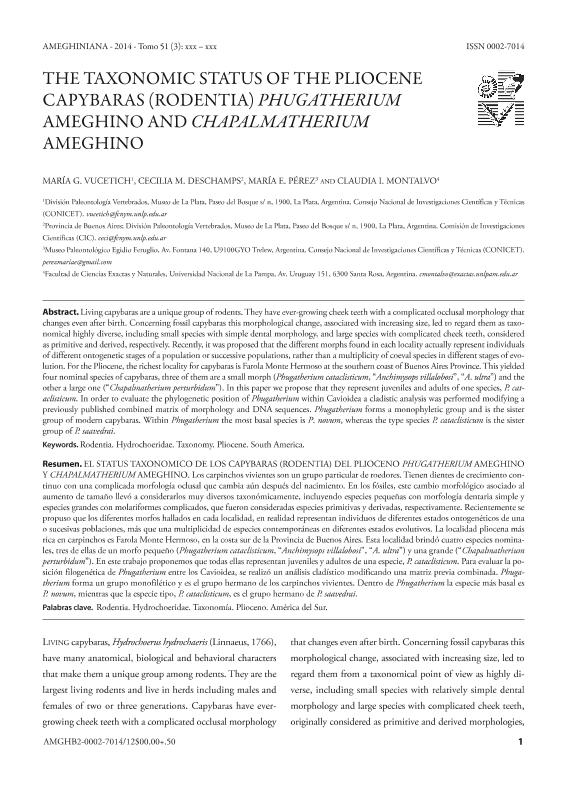Mostrar el registro sencillo del ítem
dc.contributor.author
Vucetich, Maria Guiomar

dc.contributor.author
Deschamps, Ceclilia M.

dc.contributor.author
Perez, Maria Encarnacion

dc.contributor.author
Montalvo, Claudia I.

dc.date.available
2017-05-15T15:29:37Z
dc.date.issued
2014
dc.identifier.citation
Vucetich, Maria Guiomar; Deschamps, Ceclilia M.; Perez, Maria Encarnacion; Montalvo, Claudia I.; The taxonomic status of the Pliocene Capybaras (Rodentia) Phugatherium Ameghino and Chapalmatherium Ameghino; Asociacion Paleontologica Argentina; Ameghiniana; 51; 3; -1-2014; 173-183
dc.identifier.issn
0002-7014
dc.identifier.uri
http://hdl.handle.net/11336/16475
dc.description.abstract
Living capybaras are a unique group of rodents. They have ever-growing cheek teeth with a complicated occlusal morphology that changes even after birth. Concerning fossil capybaras this morphological change, associated with increasing size, led to regard them as taxo- nomically highly diverse, including small species with simple dental morphology, and large species with complicated cheek teeth , considered as primitive and derived, respectively. Recently, it was proposed that the different morphs found in each locality actually rep resent individuals of different ontogenetic stages of a population or successive populations, rather than a multiplicity of coeval species in diff erent stages of evo- lution. For the Pliocene, the richest locality for capybaras is Farola Monte Hermoso on the southern coast of Buenos Aires Prov ince. This lo- cality yielded four nominal species of capybaras, three of them are a small morph ( Phugatherium cataclisticum Ameghino, “ Anchimysops villalobosi ” Kraglievich, “ A . ultra ” Kraglievich) and the other a large one (“ Chapalmatherium perturbidum ” (Ameghino)). In this paper we propose that they represent juveniles and adults of one species, P. cataclisticum . In order to evaluate the phylogenetic position of Phugath- erium within Cavioidea a cladistic analysis was performed modifying a previously published combined matrix of morphology and DNA sequences. Phugatherium forms a monophyletic group and is the sister group of modern capybaras. Within Phugatherium the most basal species is P . novum Ameghino, whereas the type species P. cataclisticum is the sister group of P. saavedrai Hoffstetter, Villarroel and Rodrigo.
dc.description.abstract
Los carpinchos vivientes son un grupo particular de roedores. Tienen dientes de crecimiento con- tinuo con una complicada morfología oclusal que cambia aún después del nacimiento. En los fósiles, este cambio morfológico asoc iado al aumento de tamaño llevó a considerarlos muy diversos taxonómicamente, incluyendo especies pequeñas con morfología dentaria simp le y especies grandes con molariformes complicados, que fueron consideradas especies primitivas y derivadas, respectivamente. Recien temente se propuso que los diferentes morfos hallados en cada localidad, en realidad representan individuos de diferentes estados ontogené ticos de una o sucesivas poblaciones, más que una multiplicidad de especies contemporáneas en diferentes estados evolutivos. La localidad pl iocena más rica en carpinchos es Farola Monte Hermoso, en la costa sur de la Provincia de Buenos Aires. Esta localidad brindó cuatro espec ies nomina- les, tres de ellas de un morfo pequeño ( Phugatherium cataclisticum Ameghino, “ Anchimysops villalobosi ” Kraglievich, “ A. ultra ” Kraglie- vich) y una grande (“ Chapalmatherium per turbidum ” (Ameghino)). En este trabajo proponemos que todas ellas representan juveniles y adultos de una especie, P. cataclisticum . Para evaluar la posición filogenética de Phugatherium entre los Cavioidea, se realizó un análisis cla- dístico modificando una matriz previa combinada. Phuga therium forma un grupo monofilético y es el grupo hermano de los carpinchos vivientes. Dentro de Phugatherium la especie más basal es P. novum Ameghino, mientras que la especie tipo, P. cataclisticum , es el grupo her- mano de P. saavedrai Hoffstetter, Villarroel and Rodrigo.
dc.format
application/pdf
dc.language.iso
eng
dc.publisher
Asociacion Paleontologica Argentina

dc.rights
info:eu-repo/semantics/openAccess
dc.rights.uri
https://creativecommons.org/licenses/by-nc-sa/2.5/ar/
dc.subject
Rodentia
dc.subject
Hydrochoeridae
dc.subject
Taxonomy
dc.subject
Pliocene
dc.subject
South America
dc.subject.classification
Paleontología

dc.subject.classification
Ciencias de la Tierra y relacionadas con el Medio Ambiente

dc.subject.classification
CIENCIAS NATURALES Y EXACTAS

dc.title
The taxonomic status of the Pliocene Capybaras (Rodentia) Phugatherium Ameghino and Chapalmatherium Ameghino
dc.title
El status taxonómico de los Capybaras (Rodentia) del Plioceno Phugatherium Ameghino y Chapalmatherium Ameghino
dc.type
info:eu-repo/semantics/article
dc.type
info:ar-repo/semantics/artículo
dc.type
info:eu-repo/semantics/publishedVersion
dc.date.updated
2016-12-12T14:37:01Z
dc.identifier.eissn
1851-8044
dc.journal.volume
51
dc.journal.number
3
dc.journal.pagination
173-183
dc.journal.pais
Argentina

dc.journal.ciudad
Buenos Aires
dc.description.fil
Fil: Vucetich, Maria Guiomar. Universidad Nacional de la Plata. Facultad de Ciencias Naturales y Museo. División Paleontología Vertebrados; Argentina. Consejo Nacional de Investigaciones Científicas y Técnicas; Argentina
dc.description.fil
Fil: Deschamps, Ceclilia M.. Universidad Nacional de la Plata. Facultad de Ciencias Naturales y Museo. División Paleontología Vertebrados; Argentina. Provincia de Buenos Aires. Gobernación. Comisión de Investigaciones Científicas; Argentina. Consejo Nacional de Investigaciones Científicas y Técnicas; Argentina
dc.description.fil
Fil: Perez, Maria Encarnacion. Museo Paleontológico Egidio Feruglio; Argentina. Consejo Nacional de Investigaciones Científicas y Técnicas; Argentina
dc.description.fil
Fil: Montalvo, Claudia I.. Universidad Nacional de La Pampa. Facultad de Ciencias Exactas y Naturales; Argentina
dc.journal.title
Ameghiniana

dc.relation.alternativeid
info:eu-repo/semantics/altIdentifier/doi/http://dx.doi.org/10.5710/AMGH.05.02.2014.2074
dc.relation.alternativeid
info:eu-repo/semantics/altIdentifier/url/http://www.bioone.org/doi/abs/10.5710/AMGH.05.02.2014.2074
Archivos asociados
